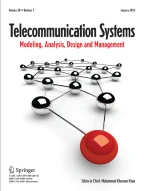Abstract
Multi-hop communication in a wireless sensor network leads to unbalanced energy consumption, creating “hot spots” around the sensor nodes. Selection of paths for the mobile sinks for hot-spot mitigation is a challenging task. In this work, we propose two multiple mobile sinks based data collection schemes, namely Direct Send and Via Static Gateway. The mobile sinks move throughout the network following two mobility patterns alternatively to reduce energy consumption and data loss and maximize network life and data collection. We formulate the problem as cooperative game with non-transferable utility, where the mobile sinks are the players. Payoff that the players receive is a function of goodness factor and energy consumption. Goodness factor is assigned to each player by the base station depending on how varied the collected data is. On the basis of received goodness factor, the players select their strategies cooperatively in order to increase their individual payoffs. The proposed algorithms are validated through simulation experiments using C programming language. Hardware test bed studies are done using Arduino sensor motes equipped with XBee antenna to validate our proposed methodology.
Similar content being viewed by others
Explore related subjects
Discover the latest articles, news and stories from top researchers in related subjects.References
Swagarya, G., Kaijage, S., & Sinde, R. S. (2014). Air pollution monitoring system based on wireless networks simulation. Innovative Systems Design and Engineering, 5(8), 1727–2222.
Perillo, M., Cheng, Z., & Heinzelman, W. (2004). On the problem of unbalanced load distribution in wireless sensor networks. In Global telecommunications conference workshops (pp. 74–79). IEEE.
Turgut, D., & Bölöni, L. (2009). Heuristic approaches for transmission scheduling in sen-sor networks with multiple mobile sinks. The Computer Journal, 54(3), 332–344.
Gao, S., Zhang, H., & Das, S. K. (2011). Efficient data collection in wireless sensor networks with path-constrained mobile sinks. IEEE Transactions on Mobile Computing, 10(4), 592–608.
Kumar, V., Kumar, A., Singh, M., et al. (2016). Improving network lifetime and reporting delay in wireless sensor networks using multiple mobile sinks. In 2016 3rd international conference on computing for sustainable global development (INDIACom) (pp. 1675–1678). IEEE.
Kweon, K., Ghim, H., Hong, J., & Yoon, H. (2009). Grid-based energy-efficient routing from multiple sources to multiple mobile sinks in wireless sensor networks. In 4th international symposium on wireless pervasive computing, ISWPC 2009 (pp. 1–5). IEEE.
Andleeb, Z., Anjum, M., & Sardar, M. U. (2016). Study the impact of multiple mobile sinks on lifetime of wireless sensor networks. In 2016 sixth international conference on innovative computing technology (IN-TECH) (pp. 418–422). IEEE.
Gill, R. K., Chawla, P., & Sachdeva, M. (2014). Study of leach routing protocol for wireless sensor networks. In International conference on communication, computing & systems (ICCCS-2014) (pp. 196–198).
Manjeshwar, A., & Agrawal, D. P. (2001). Teen: A routing protocol for enhanced efficiency in wireless sensor networks. In IEEE (p. 30189a).
Kaswan, A., Nitesh, K., & Jana, P. K. (2017). Energy efficient path selection for mobile sink and data gathering in wireless sensor networks. AEU-International Journal of Electronics and Communications, 73, 110–118.
Khoufi, I., Minet, P., Koulali, M. A., & Kobbane, A. (2016). Path planning of mobile sinks in charge of data gathering: A coalitional game theory approach. In 2016 IEEE 35th international performance computing and communications conference (IPCCC) (pp. 1–8). IEEE.
Wang, J., Cao, J., Ji, S., & Park, J. H. (2017). Energy-efficient cluster-based dynamic routes adjustment approach for wireless sensor networks with mobile sinks. The Journal of Supercomputing, 73(7), 3277–3290.
Shin, K., & Kim, S. (2012). Predictive routing for mobile sinks in wireless sensor networks: a milestone-based approach. The Journal of Supercomputing, 62(3), 1519–1536.
Wang, N. C., & Chiang, Y. K. (2011). Power-aware data dissemination protocol for grid-based wireless sensor networks with mobile sinks. IET Communications, 5(18), 2684–2691.
Wang, Z. M., Basagni, S., Melachrinoudis, E., & Petrioli, C. (2005). Exploiting sink mobility for maximizing sensor networks lifetime. In Proceedings of the 38th annual Hawaii international conference on system sciences, HICSS’05 (p. 287a). IEEE.
Mas-Colell, A., Whinston, M. D., Green, J. R., et al. (1995). Microeconomic theory (Vol. 1). New York: Oxford University Press.
Curiel, I. (2013). Cooperative game theory and applications: cooperative games arising from combinatorial optimization problems (Vol. 16). Berlin: Springer.
Chalkiadakis, G., Elkind, E., & Wooldridge, M. (2011). Computational aspects of cooperative game theory. Synthesis Lectures on Artificial Intelligence and Machine Learning, 5(6), 1–168.
Cormen, T. H., Leiserson, C. E., Rivest, R. L., & Stein, C. (2009). Introduction to algorithms. Cambridge: MIT press.
Bose, P., & Morin, P. (1999). Online routing in triangulations. In International symposium on algorithms and computation (pp. 113–122). Springer.
Nisan, N., Roughgarden, T., Tardos, E., & Vazirani, V. V. (2007). Algorithmic game theory. Cambridge: Cambridge University Press.
Chen, Z., Xiao, Y., Li, X., & Li, R. (2013). A clustering protocol for wireless sensor networks based on energy potential field. The Scientific World Journal. https://doi.org/10.1155/2013/829861.
Eshaftri, M., Al-Dubai, A. Y., Romdhani, I., & Yassien, M. B. (2015). A new energy efficient cluster based protocol for wireless sensor networks. In 2015 federated conference on computer science and information systems (FedCSIS) (pp. 1209–1214). IEEE.
Kannan, G., & Raja, T. S. R. (2015). Energy efficient distributed cluster head scheduling scheme for two tiered wireless sensor network. Egyptian Informatics Journal, 16(2), 167–174.
Arduino. (2018). Arduino uno datasheet. https://store.arduino.cc/usa/arduino-uno-rev3. Accessed 1 Dec 2017.
Digi. (2018). Xbee datasheet. https://www.digi.com/pdf/dsxbeemultipointmodules.pdf. Accessed 1 Dec 2017.
Author information
Authors and Affiliations
Corresponding author
Rights and permissions
About this article
Cite this article
Koley, I., Samanta, T. Mobile sink based data collection for energy efficient coordination in wireless sensor network using cooperative game model. Telecommun Syst 71, 377–396 (2019). https://doi.org/10.1007/s11235-018-0507-4
Published:
Issue Date:
DOI: https://doi.org/10.1007/s11235-018-0507-4
